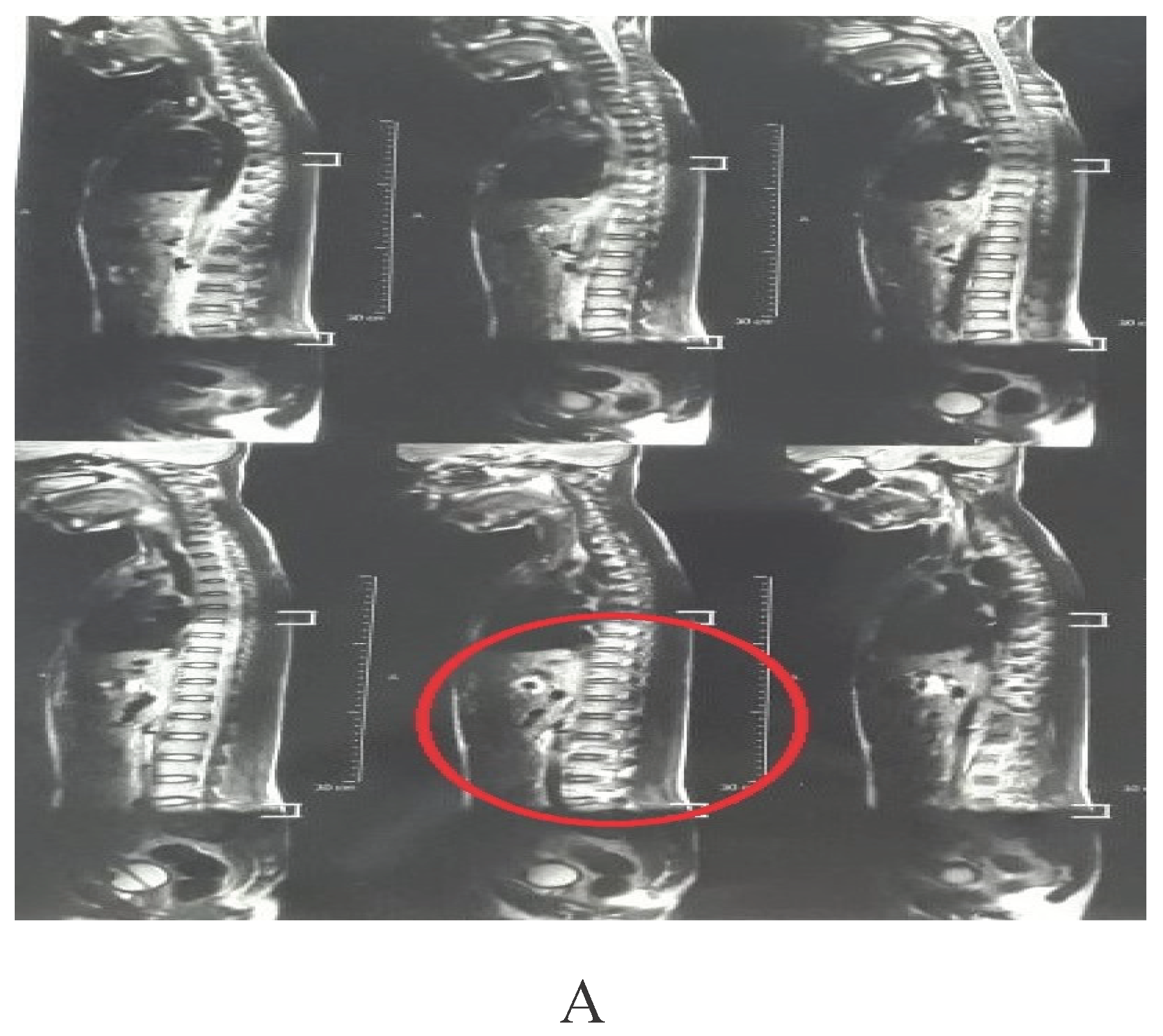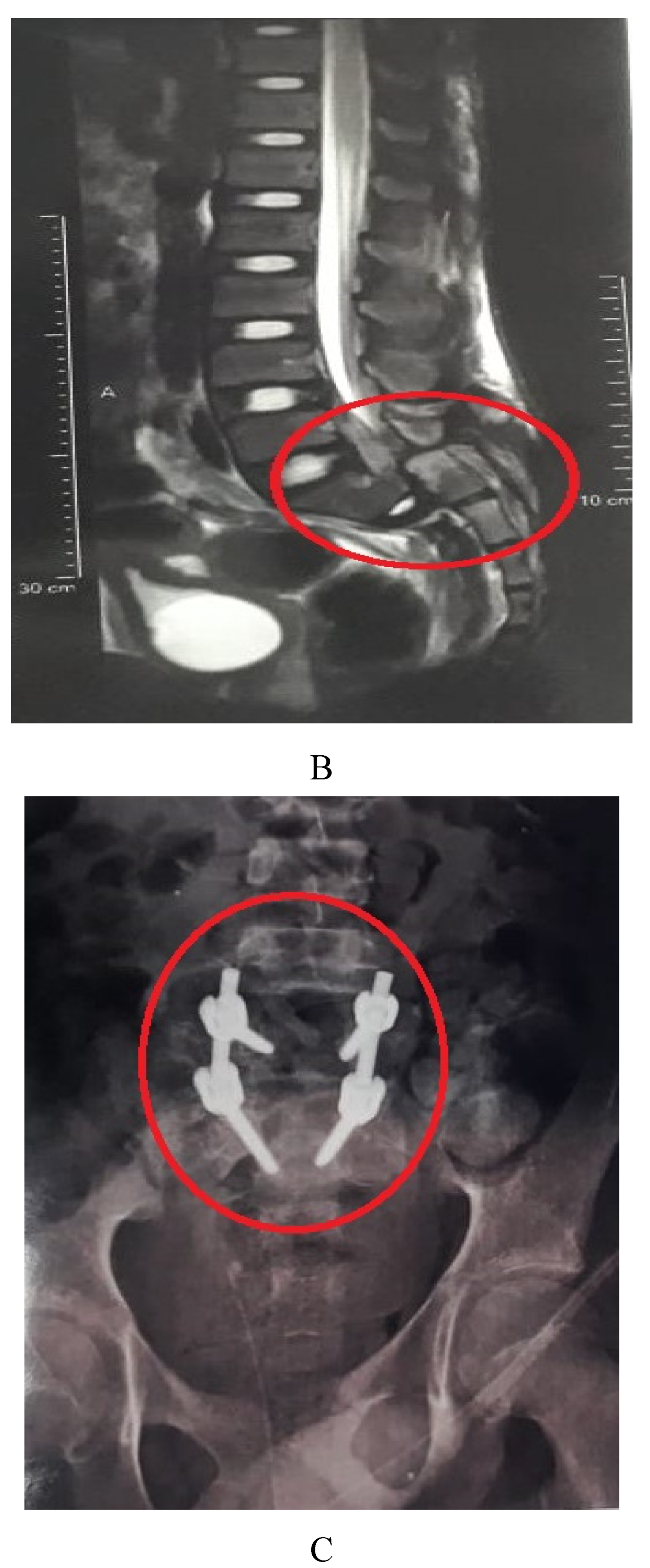Figure 1.
weighted MRI of the Spine showing flattening of the dorso-lumbar spine.
B T1 weighted MRI spine showing the Spondyloptosis of L5- S1 vertebra with cauda equine compression. According to Meyerding classification it comes under grade 5 i.e. >100% forward slip [
5]. Cauda equine syndrome is a condition in which the lower segment of the spinal cord is compressed causing bladder and bowel dysfunction also sexual dysfunction. This patient experiences incontinence of bladder and bowel, also patient feels the filling of the bladder and bowel but there is loss of urge to void the urine and stool [
6,
7].
C- Showing the post-operative X-ray of Spinal fusion with rods and pedicle screws A-P view Surgical treatment is the only for traumatic spondyloptosis is reasonable. Surgery aims to reduce, decompress, stabilize, and fuse the spondyloptotic segment [
8]. In this patient a posterior approach with decompression is used to re-align the vertebral segments and to maintain the integrity of the spinal cord. There is fixation of L5- S1 with pedicle screws and rods.
Figure 1.
weighted MRI of the Spine showing flattening of the dorso-lumbar spine.
B T1 weighted MRI spine showing the Spondyloptosis of L5- S1 vertebra with cauda equine compression. According to Meyerding classification it comes under grade 5 i.e. >100% forward slip [
5]. Cauda equine syndrome is a condition in which the lower segment of the spinal cord is compressed causing bladder and bowel dysfunction also sexual dysfunction. This patient experiences incontinence of bladder and bowel, also patient feels the filling of the bladder and bowel but there is loss of urge to void the urine and stool [
6,
7].
C- Showing the post-operative X-ray of Spinal fusion with rods and pedicle screws A-P view Surgical treatment is the only for traumatic spondyloptosis is reasonable. Surgery aims to reduce, decompress, stabilize, and fuse the spondyloptotic segment [
8]. In this patient a posterior approach with decompression is used to re-align the vertebral segments and to maintain the integrity of the spinal cord. There is fixation of L5- S1 with pedicle screws and rods.


Author Contributions
Conceptualization, writing—original draft preparation by Swadha P. Udhoji writing review and editing by Raghuveer Raghumahanti. The author has read and agreed to the published version of the manuscript.
Funding
The present research received no external funding.
Institutional Review Board Statement
Not Applicable.
Informed Consent Statement
Informed consent was taken from the patient’s parent
Conflicts of Interest
The authors declare no conflict of interest.
References
- Chandrashekhara, S.H.; Kumar, A.; Gamanagatti, S.; Kapoor, K.; Mukund, A.; Aggarwal, D.; Sinha, S. Unusual Traumatic Spondyloptosis Causing Complete Transaction of Spinal Cord. Int. Orthop. 2011, 35, 1671–1675. [CrossRef]
- Gaines, R.W. L5 Vertebrectomy for the Surgical Treatment of Spondyloptosis: Thirty Cases in 25 Years. Spine 2005, 30, S66–S70.
- Benevento, B.T.; Sipski, M.L. Neurogenic Bladder, Neurogenic Bowel, and Sexual Dysfunction in People with Spinal Cord Injury. Phys. Ther. 2002, 82, 601–612. [CrossRef]
- Park, Y.I.; Linsenmeyer, T.A. A Method to Minimize Indwelling Catheter Calcification and Bladder Stones in Individuals with Spinal Cord Injury. J. Spinal Cord Med. 2001, 24, 105–108. [CrossRef]
- Studnicka, K.; Ampat, G. Lumbosacral Spondylolisthesis. In StatPearls [Internet]; StatPearls Publishing, 2023.
- Fraser, S.; Roberts, L.; Murphy, E. Cauda Equina Syndrome: A Literature Review of Its Definition and Clinical Presentation. Arch. Phys. Med. Rehabil. 2009, 90, 1964–1968. [CrossRef]
- Lavy, C.; Marks, P.; Dangas, K.; Todd, N. Cauda Equina Syndrome—a Practical Guide to Definition and Classification. Int. Orthop. 2022, 1–5. [CrossRef]
- Daniels, A.H.; Deodhar, A.A.; Hart, R.A. Traumatic Spondyloptosis Resulting from High-Energy Trauma Concurrent with a Tonic-Clonic Seizure. Spine J. 2009, 9, e1–e4. [CrossRef]
|
Disclaimer/Publisher’s Note: The statements, opinions and data contained in all publications are solely those of the individual author(s) and contributor(s) and not of MDPI and/or the editor(s). MDPI and/or the editor(s) disclaim responsibility for any injury to people or property resulting from any ideas, methods, instructions or products referred to in the content. |
© 2023 by the authors. Licensee MDPI, Basel, Switzerland. This article is an open access article distributed under the terms and conditions of the Creative Commons Attribution (CC BY) license (http://creativecommons.org/licenses/by/4.0/).





